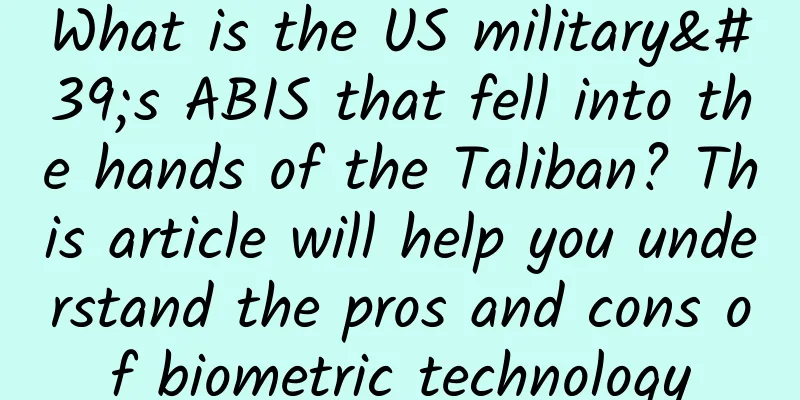What is the US military's ABIS that fell into the hands of the Taliban? This article will help you understand the pros and cons of biometric technology

|
What kind of high-tech is the US military's ABIS system that fell into the hands of the Taliban? Why is it called the most advanced biometric technology at present? Will it make your personal information more secure in the future? Written by reporter Zhao Tianyu, Photo and text editor Chen Yongjie Image source/Visual China Interview experts: Yu Naigong Professor of Beijing University of Technology, School of Automation, Faculty of Information Science Deputy Director of the Institute of Artificial Intelligence and Robotics As the US military withdraws from Afghanistan, the latest and most advanced US biometric identification technology (ABIS) system has also fallen into the hands of the Taliban. Originally used to guard against the Taliban and terrorist organizations, the biological equipment is now used by the Taliban to hunt down the US "allies" in Afghanistan, staging a farce of "outsmarting oneself". ▲Biometrics technology not only includes face recognition, but also iris, fingerprint, DNA and other biological data can be used for identification What exactly is the ABIS system? Why is it called the most advanced biometric technology at present? How will biometric technology develop in the future? ◆ ◆ ◆ The missing "handheld scanner" According to media reports, during the hasty withdrawal of the United States from Afghanistan, not only a large number of weapons and ammunition were seized by the Taliban, but also a US-made handheld scanner. The Taliban said that using this high-tech instrument, they can access the huge biometric database built by the United States to hunt down Afghans who have helped the United States and its allies in the past 20 years. The "high-tech instrument" mentioned by the Taliban is the HIIDE scanner: a small device that integrates a fingerprint reader, an iris scanner and a camera. It can scan and collect irises and fingerprints as well as facial photos. Unlike traditional single-pattern recognition tools, HIIDE can use three independent biometric technologies to establish and verify people's identities. Behind the HIIDE device is an automated biometric system that the United States has spent more than a decade to painstakingly build and operate. △On the border between Afghanistan and Pakistan, the US military is using HIIDE scanners to collect people's biometric information (Photo source: Visual China) The increasingly rampant terrorist attacks in recent years have made it impossible for traditional identification methods to identify terrorists or so-called "potential enemies", which has caused headaches for Americans. Therefore, the United States tried to use technological means to solve the problem. Since 2004, with the joint efforts of the US military and the Department of Defense, an automated biometric identification system ABIS has been established. In Afghanistan, its collection and identification tool is the HIIDE mentioned above. In 2011, the famous terrorist Osama bin Laden was killed, and the Americans used this system to perform facial recognition to confirm Bin Laden's identity. Later, the system began to be widely used (in Afghanistan), and American soldiers carried the information with them. In the past 12 years, almost everyone who has cooperated with the Afghan government or the US military has had their fingerprints and irises scanned and stored in this biometric database. Today, the ABIS database has stored about 8 million identities, and the number is still growing rapidly. It is reported that with the hasty withdrawal of the US military, at least 7,000 such handheld scanners are currently "missing", and it is also unclear whether the biometric database stored in the scanners can be remotely deleted. △The public who are undergoing biometric information collection In addition to ABIS, the NGI system developed by the FBI is also one of the most widely used biometric systems: NGI's biometric measurement mode includes not only fingerprints, but also palm prints, facial photos, and even scar and tattoo comparisons. The recognition system can access more than 411.9 million facial images, including a large number of foreign citizens. ◆ ◆ ◆ The evolution and improvement of biometric technology In fact, whether it is the ABIS system or the NGI system, with the development of information technology, today's biometric technology has begun to shift from single modality to multimodality, and from military to commercial and civilian use. Biometric technology refers to a technology that uses the inherent physiological and behavioral characteristics of the human body to identify individuals through the close combination of computers with high-tech means such as optics, acoustics, biosensors and biostatistics. Nowadays, fingerprint recognition technology, which is widely used in our daily lives, face recognition technology, which is gradually being used, and iris recognition technology, which has a higher technological content, are all biometric technologies. ▲The global biometric technology application market has broad prospects Biometric technology is not actually a brand new technology. On the contrary, it has been around since the 1960s: in 1969, the US FBI promoted the development of automatic fingerprint recognition technology. By 1975, the first scanner for extracting fingerprint points had been formed, but it failed to be promoted due to the high cost of digital storage. In the 1990s, commercial biometric products began to appear. By the beginning of the 21st century, palm print biometric marker technology began to enter the biometric identification stage, and facial recognition also began to be used in customs, airports and other places, becoming a globally recognized biometric authenticator. After 2013, as Apple phones added fingerprint recognition, biometric technology was no longer a government tool, but transformed into a mass consumer product, ushering in rapid development. In the following years, various forms of biometric technology have been applied in the market, and the technology route has also undergone iterations, realizing the transition from the first generation to the second generation. Biological-based recognition technology is reshaping the authentication industry. ◆ ◆ ◆ The pros and cons of multimodal biometrics Compared with traditional password or pattern authentication, the security and accuracy of biometric technology have been greatly improved. However, no matter which generation of biometric products, any biometric technology actually has its own limitations. Yu Naigong, professor at Beijing University of Technology and deputy director of the Institute of Artificial Intelligence and Robotics, School of Automation, School of Information Science, told reporters that fingerprint recognition has very high requirements on the environment, facial recognition cannot distinguish between twins and people wearing masks, and iris recognition is too expensive. "With the widespread application of technology and the increase in users, different information is loaded from different sensors. Single-modal recognition is difficult to meet the application development under high security, multiple scenarios, and large databases." Yu Naigong said that this requires the integrated development of multiple biometric technologies, so multimodal biometric technology began to have a market and transformed from military to commercial use. For example, in the field of government inspection, the information collectors, ID card readers, identity verification terminals and other equipment currently used in the certificate processing halls of immigration, public security, social security and other institutions are products that use multimodal recognition technology. According to a research report by MarketsandMarkets, the world's second largest market research consulting firm, it is predicted that from 2020 to 2025, the global biometric technology application market size will increase from US$36.6 billion to US$68.6 billion, with a compound annual growth rate of 13.4%. Biometric technology will enter a period of rapid growth, and a considerable part of this growth will come from multimodal recognition technology. "From the perspective of security, multimodal biometric technology can strengthen the verification of the identity of specific persons and help protect user information and data security. But from the perspective of information security, multimodal technology stores more personal information, which actually puts higher demands on data security protection," said Yu Naigong. ▲Biometrics technology will usher in new focus in the future, integrating with the Internet and the Internet of Things to provide better security and convenience Previously, many cities in the United States banned facial recognition technology due to privacy issues. Cases of personal information leakage in China are also common. This year's 315 Gala also exposed a company's use of facial recognition for "malicious marketing." Single-modal biometrics can cause serious information leakage, which is bound to be even worse for multi-modal recognition. It is hard to say that it will not affect the popularity of the technology. In terms of market selection, multimodal recognition has not yet been used on a large scale in civilian settings, its commercialization level is limited, there are few participating companies and the cost is relatively high. In the future, it will still need to face the test of the market during its implementation. Yu Naigong believes that although multimodal systems have obvious advantages, they are limited by cost and technical support. Under the premise of meeting the needs, single-modal recognition technology is still the mainstream in the field of civilian recognition at this stage. In the future, as costs decrease, more multimodal biometric recognition systems are expected to appear on the market and compete with single-modal recognition systems. It is worth mentioning that in addition to multimodal biometrics, the second generation of biometrics has also begun to emerge in recent years. The second generation of biometrics uses deeper biological keys of the human body to operate, such as vein recognition, retinal recognition, bone recognition, etc. The two most critical factors that distinguish the first and second generation of biometrics are the visibility of the features and whether liveness recognition can be performed. From a security perspective, the second generation has more advantages than the first generation of biometrics and is more secure. Therefore, for consumers, whether it is multimodal biometric technology or technology based on second-generation deep biometric features, there will be more abundant identification methods to choose from in the future. Biometric technology will usher in a new focus in the future, integrating with the Internet and the Internet of Things to provide better security and convenience. 【References】 The True Story of Afghanistan's Abandoned Biometric Database, MIT Technology Review HIIDE portable biometric device scans irises, fingers and faces Ben Coxworth Afghanistan: Will fingerprint data target the Taliban? Chris Vallance Produced by: Science Central Kitchen Produced by: Beijing Science and Technology News | Science Plus Client Welcome to share to your circle of friends |
<<: Understand the September 18th Incident in one breath!
>>: Lilies from southwest China bloom in botanical gardens around the world
Recommend
Are wristbands a viable solution to the problem of video game peripherals?
Since the beginning of the year, motion-sensing b...
How can we conduct a good competitive analysis of B-side products? Share 3 points!
Competitive product analysis is a must for produc...
The expiration date of a drug is not equal to its expiration date! Collect this "preservation secret"
How long can the medicines at home be preserved o...
Sweetness is the result of a long process of hard work: How hard will humans work for a taste of sweetness?
Produced by: Science Popularization China Author:...
What are the advantages and disadvantages of Wancibaping promotion?
Presumably, many friends who are engaged in onlin...
Xiaohongshu Comprehensive Promotion and Traffic Guide
The four words "promotion and traffic genera...
How should brands operate Bilibili in 2021?
The new year of 2021 is here. Recently, when I wa...
Zhang Fuyuan's "3-minute freehand face sculpting" can slim your face, adjust your face shape, remove spots, and tighten your skin
No surgery or injections are required, it is abso...
After two years, NIO's 50,000th vehicle rolled off the assembly line
As one of the earliest new energy vehicle compani...
A Brief Analysis of High-Performance IO Model
A Brief Analysis of High-Performance IO Model Ser...
The i7-3960X has become a "foreign garbage": Can it drive the GTX 1080?
Many people think that playing games only require...
The sky is falling! The fleece pants you love most in winter are actually poisonous?
Recently, the content about composite fleece pant...
How to accurately estimate user intent when placing Baidu information flow ads in the home improvement industry?
The home improvement industry is a typical large ...
What problems has Apple’s core business encountered in the past year?
The common perception is that Apple products are ...
How can you use scientific means to force yourself to have a better mood?
Self-admiration method. This method is very simpl...









